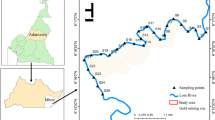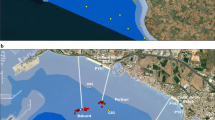Abstract
The research depicts the spatial and temporal variation of major and trace metals in marine sediments at various monitoring stations of Dhamra estuary, Bay of Bengal, Odisha. The concentration and distribution of selected metals in surface sediments of the estuary were studied in order to assess the spatial extent of anthropogenic inputs viz., mining activities and to estimate the effects of seasonal variations on geochemical processes in this particular tropical estuarine system. Surface sediments reflect the presence of trace and major metals in parts per million, and the concentrations vary in the range of Cu (0.083 to 127.2), Ni (17.35 to 122.8), Co (1.2 to 31.58), Pb (0.8 to 95.86), Zn (12.1 to 415), Cd (0 to 11) and Cr (35.21 to 5,890), Fe (7,490 and 169,100), Mn (20 to 69,188), Ca (10 to 10,520), Mg (990 to 28,750), Na (300 to 51,700), and K (1,100 to 30,010). The comparison of spatial distribution of metal contents using GIS in marine sediments indicates that there is a substantial anthropogenic input in the Dhamra estuary. The enrichment of Cr is ascribed to the sedimentation of Brahmani River, passing through the mining region and discharging Cr pollutant to the sea. Similarly, the sources of Cd are attributable to corrosion-resistant paints used by a large number of trawlers. Contamination factor has been calculated for various metals to assess the degree of pollution. As per Hakanson’s classification, Cr indicates very high contamination with considerable contamination of Cd, whereas moderate contamination of Pb, Zn, and Mn are observed in marine sediments. Pollution load index also indicate that there is deterioration of site quality in premonsoon season, which almost attains the baseline level in post monsoon and perfection in monsoon season (Tomlinson et al. (Helgolander Wissenschaftliche Meeresuntersuchungen, 33, 566–572, 1980)). The geoaccumulation index shows that the metal concentrations in sediments can be considered as background levels except Cr and Cd. The geoaccumulation index shows that Cr is moderately contaminated and it is higher in offshore region in post monsoon and monsoon than premonsoon season. All the calculated indices show that Cr and Cd levels are more than the desired limits in the marine sediments. Multivariate statistical analysis evaluates the plausible sources of contaminants, attributing to mining, industrial, and urban wastes by way of Brahmani River discharging to the estuarine region.







Similar content being viewed by others
References
Adriano, D. C. (2001). Trace metals in terrestrial environments: biogeochemistry, bioavailability and risks of metals. New York: Springer.
Aksu, A. E., Yasar, D., & Uslu, O. (1998). Assessment of marine pollution in Izmir Bay: heavy metal and organic compound concentrations in surficial sediments. Turkish Journal of Engineering and Environmental Sciences, 22, 387–415.
Atteia, O., Dubois, J. P., & Webster, R. (1994). Geostatistical analysis of soil contamination in the Swiss Jura. Environmental Pollution, 86, 315–327.
Beiras, R., Bellas, J., Fernández, N., Lorenzo, J. I., & Cobela-García, A. (2003). Assessment of coastal marine pollution in Galicia (NW Iberian Peninsula); metal concentrations in seawater, sediments and mussels (Mytilus galloprovincialis) versus embryo-larval bioassays using Paracentrotus lividus and Ciona intestinalis. Marine Environmental Research, 56, 531–553.
Buat-Menard, P., & Chesselet, R. (1979). Variable influence of the atmospheric flux on the trace metal chemistry of oceanic suspended matter. Earth Planet Science Letter, 42, 398–411.
Bustard, H. R., & Kar, S. (1981). Annual nesting of the Pacific ridley sea turtle (Lepidochelys olivacea) in Odisha, India. British Journal of Herpetology, 6, 139.
Caccia, V. G., Millero, F. J., & Palanques, A. (2003). The distribution of trace metals in Florida Bay sediments. Marine Pollution Bulletin, 46, 1420–1433.
Calvert, S., & Pedersen, T. (1993). Geochemistry of recent oxic and anoxic marine sediments: implications for the geological records. Marine Geology, 11, 67–88.
Chakravarty, M., & Patgiri, A. D. (2009). Metal pollution assessment in sediments of the Dikrong River, NE India. Journal of Human Ecology, 27, 63–67.
Dash, M. C., & Kar, C. S. (1990). The turtle paradise, Gahirmatha: an ecological analysis and conservation strategy (pp. 1–295). New Delhi: Interprint press.
Dekov, V. M., Subramanian, V., Van Grieken, R., (1999). Chemical composition of reverie suspended matter and sediments from the Indian sub-continent. In V. Ittekkot, V. Subramanian, & S. Annadurai (Eds.), Biogeochemistry of rivers in tropical South and Southeast Asia. Heft 82, SCOPE Sonderband, Mitteilugen ausdem Geologisch-Paläontolgischen (pp. 99–109). Institut der Universitat: Hamburg.
Einax, J. W., Zwanzinger, H. W., & Geib, S. (1997). Chemometrics in environmental analysis. Weinheim: Wiley-VCH.
Elsdon, T. S., & Connell, S. D. (2009). Spatial and temporal monitoring of coastal water quality: refining the way we consider, gather, and interpret patterns. Aquatic Biology, 5, 157–166.
El Nemr, A., Khaled, A. & Sikaily, A. E. (2006). Distribution and statistical analysis of leachable and total heavy metals in the sediments of the Suez Gulf. Environmental Monitoring and Assessment, 118, 89–112.
Facchinelli, A., Sacchi, E., & Mallen, L. (2001). Multivariate statistical and GIS-based approach to identify heavy metal sources in soils. Environmental Pollution, 114, 245–276.
Flanagan, F. J. (1973). 1972 values for international geochemical reference samples. Geochimica Cosmochimica Acta, 37, 1189–1200.
Gaudette, H. E., Flight, W. R., Toner, L., & Folger, D. W. (1974). An inexpensive titration method for the detection of organic carbon in recent sediments. Journal of Sediment Petrology, 44, 249–253.
Hakanson, L. (1980). Ecological risk index for aquatic pollution control, a sedimentological approach. Water Research, 14, 975–1001.
Harbison, P. (1984). Regional variation in the distribution of trace metals in modern intertidal sediments of northern Spencer Gulf, South Australia. Marine Geology, 61, 221–247.
Lewis, D. W. (1984). Practical sedimentology (p. 227). Pennsylvania: Hutchinson Ross Publishing Company.
Muller, G. (1969). Index of Geoaccumulation in the sediments of the Rhine River. Geojournal, 2, 108–118.
Nasr, M. S., Okbah, M. A., & Kasem, S. M. (2006). Environmental assessment of heavy metal pollution in bottom sediment of Aden port, Yemen. International Journal of Oceans and Oceanography, 1, 99–109.
Navarro, A., & Cardellachand, E. (2009). Mobilization of Ag, heavy metals and Eu from the waste deposit of the Las Herrerias mine (Almería, SE Spain). Environmental Geology, 56(7), 1389–1404.
O’Regan, P. R. (1996). The use of contemporary information technologies for coastal research and management - a review. Journal of Coastal Research, 12, 192–204.
Pekey, H. (2006). Heavy metals pollution assessment in sediments of the Izmit Bay, Turkey. Environmental Monitoring and Assessment, 123, 219–231.
Ravichandran, M., Baskaran, M., Santschi, P. H., & Bianchi, T. (1995). History of trace metal pollution in Sabine-Neches Estuary, Beaumont, Texas. Environmental Science and Technology, 29, 1495–1503.
Richard, R., Rendigs, M., & Bothner, H. (2001). United States of Geological Survey Report, 01–499
Ridgway, J., & Shimmield, G. (2002). Estuaries as repositories of historical contamination and their impact on shelf seas. Estuarine, Coastal and Shelf Science, 55, 903–928.
Riley, J. P., & Chester, R. (1971). An introduction to marine chemistry. London: Academic.
Roy, S., & Katpatal, Y. B. (2011). Cyclical hierarchical modeling for water quality model-based DSS module in an urban river system. Journal of Environmental Engineering, 137(12), 1176–1184.
Salomons, W., & Forstner, U. (1984). Metals in hydrocycle (pp. 63–98). Berlin: Springer.
Satapathy, D. R., Salve, P. R., & Katpatal, Y. B. (2009). Spatial distribution of metals in ground/surface waters in the Chandrapur district (Central India) and their plausible sources. Environmental Geology, 56, 1323–1352.
Schurch, M., Edmunds, W. M., & Buckley, D. (2004). Three-dimensional flow and trace metal mobility in shallow Chalk groundwater, Dorset, United Kingdom. Journal of Hydrology, 292(1–4), 229–248.
Seshan, B. R. R., Natesan, U., & Deepthi, K. (2010). Geochemical and statistical approach for evaluation of heavy metal pollution in core sediments in southeast coast of India. International Journal of Environmental Science and Technology, 7, 291–306.
Sharma, V. K., Rhudy, K. B., Koenig, R., Baggett, A. T., Hollyfield, S., & Vazquez, F. G. (1999). Metals in sediments of Texas estuaries, USA. Journal of Environmental Science and Health, 34, 2061–2073.
Shepard, F. P. (1954). Nomenclature based on sand-silt-clay ratios. Journal of Sedimentary Petrology, 24, 151–158.
Simex, S. A., & Helz, G. R. (1981). Regional geochemistry of trace elements in Chesapeake Bay. Environmental Geology, 3, 315–323.
Stanbury, K. B., & Starr, R. M. (1999). Applications of Geographic Information Systems (GIS) to habitat assessment and marine resource management. Oceanologica Acta, 22, 699–703.
Sutherland, R. A. (2000). Bed sediment-associated trace metals in an urban stream, Oahu, Hawaii. Environmental Geology, 39, 611–627.
Tao, S. (1995). Kriging and mapping of copper, lead and mercury contents in surface soil in Shenzhen area. Water Air Soil Pollution, 83, 161–172.
Tessier, A., Campbell, P. G. C., & Bisson, M. (1979). Sequential extraction procedures for the speciation of particulate trace metals. Analytical Chemistry, 51, 844–851.
Tomlinson, D. L., Wilson, J. G., Harris, C. R., & Jeffney, D. W. (1980). Problems in the assessment of heavy metal levels in estuaries and the formation of a pollution index. Helgoländer Wissenschaftliche Meeresuntersuchungen, 33, 566–572.
Tuncer, G., Tunce, G., & Balkaş, T. I. (2001). Evolution of metal pollution in the golden horn (Turkey) sediments between 1912 and 1987. Marine Pollution Bulletin, 5, 350–360.
Turekian, K. K., & Wedepohl, K. H. (1961). Distribution of the elements in some major units of the earth’s crust. Bulletin Geological Society of America, 72, 175–192.
Turner, A. (2000). Trace metal concentration in sediments from U.K. Estuaries: an empirical evaluation of the role of hydrous iron and manganese oxides. Estuarine, Coastal and Shelf Science, 50, 355–371.
Vazquez, F. G., & Sharma, V. K. (2004). Major and trace elements in sediments of the Campeche Sound, southeast Gulf of Mexico. Marine Pollution Bulletin, 48, 87–90.
Wang, F. H. (2006). Quantitative methods and applications in GIS. New York: Taylor & Francis.
Wentworth, C. K. (1922). A scale of grade and class terms for clastic sediments. Journal of Geology, 30, 377–392.
Wiechula, L., Loska, K., & Wiechula, D. (2003). Application of principal component analysis for the estimation of source of heavy metal contamination in surface sediments from the Rybnik Reservoir. Chemosphere, 51, 723–733.
Wolanski, E. (2007). Estuarine ecohydrology. Amsterdam: Elsevier. ISBN 978-0-444-53066-0.
Zhou, F., Guo, H. C., & Liu, L. (2007). Quantitative identification and source apportionment of anthropogenic heavy metals in marine sediment of Hong Kong. Environmental Geology, 53(2), 295–305.
Acknowledgments
The authors would like to thank Prof. (Dr.) B. K. Mishra, Director, Institute of Minerals and Materials Technology (IMMT) for his constant guidance, encouragement, and motivation in working and disseminating. The financial grant from the Dhamra Port Corporation Limited (DPCL), Government of India is gratefully acknowledged. Thanks are also extended to all the project personnel who have provided technical and operational assistance in the collection and analysis of samples during the monitoring program.
Author information
Authors and Affiliations
Corresponding author
Rights and permissions
About this article
Cite this article
Satapathy, D.R., Panda, C.R. Spatio-temporal distribution of major and trace metals in estuarine sediments of Dhamra, Bay of Bengal, India—its environmental significance. Environ Monit Assess 187, 4133 (2015). https://doi.org/10.1007/s10661-014-4133-7
Received:
Accepted:
Published:
DOI: https://doi.org/10.1007/s10661-014-4133-7




